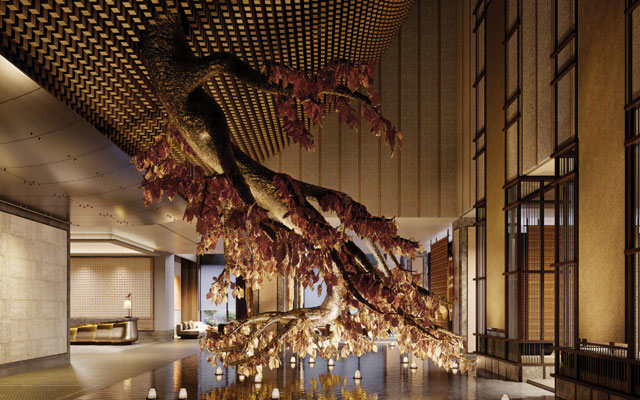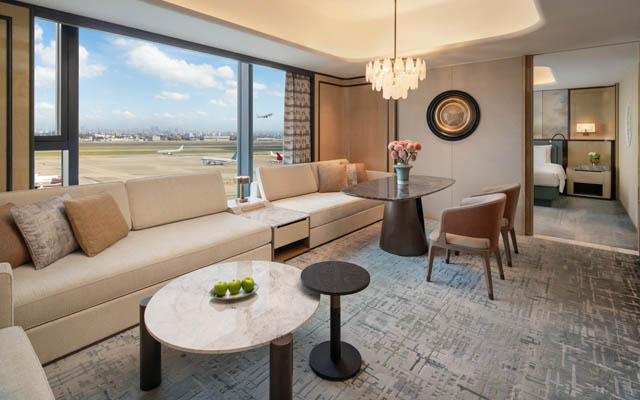Hotels today can be mini time capsules – offering a past steeped in heritage, a present grounded in nature and local immersion, and a future powered by wellness and sustainability – proving that a single property can be both a custodian of history and a blueprint for what’s to come
In 2025, hotels are no longer just places for weary travellers to rest and refuel; in the hands of visionary designers, they have become vessels for time travel – liminal spaces where past legacies, present-day narratives, and future ambitions converge.
Lobbies double as living rooms for locals and guests alike. Landscapes are conceived as wellness infrastructure. Architecture blurs the lines between nature and the built world, all while keeping one eye firmly on the decades ahead.

Past: Cultural revival as a portal to history
At Dusit Central Park, Bangkok, Thailand, a flagship restoration in collaboration with Thailand’s Silpakorn University – renowned for its arts heritage – sets a benchmark for living history.
Led by Dragon Company with interiors by André Fu Studio, the rebuild of the group’s 1970 property, described by Dusit Thani’s group CEO Suphajee Suthumpan as “deeply personal”, preserves original elements, from the iconic spire to cultural motif pillars, while upgrading comfort and sustainability.
Balconies have been replaced with bay windows so guests can enjoy panoramic views of Lumpini Park shielded from city pollution, while the mixed-use complex also houses a new retail centre and the largest urban rooftop park in the city centre.
Aman Nai Lert Bangkok in Thailand – opened in April 2025 – also takes history as a key reference. It integrates the historic Nai Lert Park Heritage Home – built by Phraya Bhakdinorasreth “Nai Lert”, a visionary entrepreneur who helped shape modern Bangkok – into a serene ultra-luxury sanctuary anchored by a century-old Chamchuri tree at its centre.
“Nai Lert’s rich heritage provided an incredible foundation for this project. Our goal was to honour this legacy and Thai culture in a modern, timeless way alongside Aman’s renowned design DNA, developed over three decades,” shared Jean-Michel Gathy, principal and founder of Denniston.
Heritage revival is not limited to bricks and mortar. At InterContinental Danang Sun Peninsula Resort, the Bill Bensley Digital Design Tour, launched in January 2025, adds an immersive high-tech twist, guiding in-house guests via smart devices through the designer’s inspirations from Vietnamese culture, nature, and heritage across four themed levels – as if Bensley himself were guiding them through.
Present: Nature-positive, community connected design
In the present, hotels ground guests in place through nature-positive and community-connected design.
“Guests seek more than accommodation; they desire immersive narratives that connect them to the local culture,” said Stéphane Lasserre, HKS studio practice leader for hospitality, who champions biophilic and place-based design.
“Hotel design has shifted from stylised representations of place to deeply authentic, destination-rooted experiences,” he added.

HKS, which has worked on mega-projects, such as Resorts World Sentosa Island Master Plan (2019) and Shanghai West Bund Mandarin Oriental Hotel and Convention Center (2028), today applies circular systems, AI modelling, and community collaboration to ensure spaces give more than they take – socially, ecologically, and economically.
Patrick Keane, founder of Enter Projects Asia, identified three trends driving hotel design today: New locations, including new markets and new destinations; going local – engaging community & community arts and crafts; and barefoot luxury, or sustainable eco-luxury.
He noted that post-lockdown, nature-driven concepts have moved from niche to mainstream, and that even “the most conservative design briefs” now include references to nature’s materials.
“Before the pandemic, the ideas of wellness and plant-based sustainability and community engagement and going local were all niche concepts. But now, they’ve become mainstream concepts that everybody has to somehow engage in to have that relevance or risk looking completely out of date,” he noted.
“All our ceilings for the lobby and conference facilities at the new South Palms Resort and Spa Panglao – MGallery Collection in Bohol (the Philippines) are cloud-like patterns made from one-kilometre of rattan – saving over one-kilometre of plastic and toxic materials by a simple move of switching to an abundant, tactile natural material,” Keane said.
He defined three “flavours” of genuine sustainability impact: performance (energy efficiency, passive cooling), arts and crafts (low-impact, local materials), and biophilic design (organic forms and plant integration), noting that certifications have now modernised this concept.
Keane cautioned against tokenism – such as eliminating plastic straws, but placing plastic furniture around the pool – and championed early design decisions that truly reduce impact.
For Siriporn Sririam, a biologist and nature conservationist serving as senior project officer, Thailand & regional at Agence Française de Développement (AFD), nature-positive tourism means rethinking hotel design to actively protect biodiversity – from property design that reduces impact to coastal areas, to beachfront hotels that actively reduce light pollution to support turtle nesting.
Thoughtful menu design plays a part too, such as a 2024 project at Jaras Restaurant, InterContinental Phuket Resort, where a partnership with WWF Thailand brought invasive species like blackchin tilapia into a zero-waste fine-dining menu to drive ecological balance.
Future: Wellness as a bridge to longevity
Today’s hotel narrative also extends into the future, where technology-integrated wellness and sustainability become dual bridges to future-proofing both people and the planet.
“Wellness has transcended the traditional spa to become an intrinsic element woven throughout the entire hotel experience,” explained Lasserre, adding that HKS, with assistance from its research team, incorporates scientifically backed principles of brain wellness and emotional design, curating rooms to evoke specific emotions through thoughtful selections of furniture, fittings, and natural materials.
Robert Day, HKS studio leader for master planning and landscapes, pointed to the emergence of integrative wellness.
“Luxury properties are increasingly offering an expanded suite of wellness facilities – including world-class healthcare capabilities – while retaining the comfort, aesthetics, and service standards of a luxury resort,” he said.
He anticipates more high-end retreats that seamlessly integrate advanced treatment facilities into their environments, creating transformative sanctuaries where guests can invest in preventative health, longevity, and lifestyle renewal within an elevated travel experience.
Wanviput Sanphasitvong, a physician at VitaLife Scientific Wellness Center and Bumrungrad International Hospital, echoed these observations, noting that wellness travellers are increasingly seeking proven results and “want to get younger by staying in these (wellness) hotels”.
The Siro brand, billed as the world’s first fitness and recovery-themed hotel, designed by LW Design Group in Dubai’s One Za’abeel, exemplifies this shift.
“Our vision was to design not just a hotel, but a comprehensive wellness ecosystem where every element enhances the guest’s journey toward optimal health,” said Pooja Shah-Mulani, LW’s creative managing partner.
Keane foresees a “plant-based revolution” in building materials that mirror sustainability trends across industries. This will result in tactile spaces that feel alive.
“We see ourselves as part of this shift. The Industrial Revolution, more than 200 years ago, transformed construction with steel. Now, I believe we’re moving toward plant-based solutions: bamboo, rattan, recycled wood products, and cross-laminated timber. That’s the direction I see the industry taking,” he stated.
Lasserre noted “future-proofing” as a key trend, where hotel spaces are designed to remain relevant for decades, while Day said the rise of ‘bleisure’ would result in ever more liminal spaces that could transition seamlessly between work and play.











